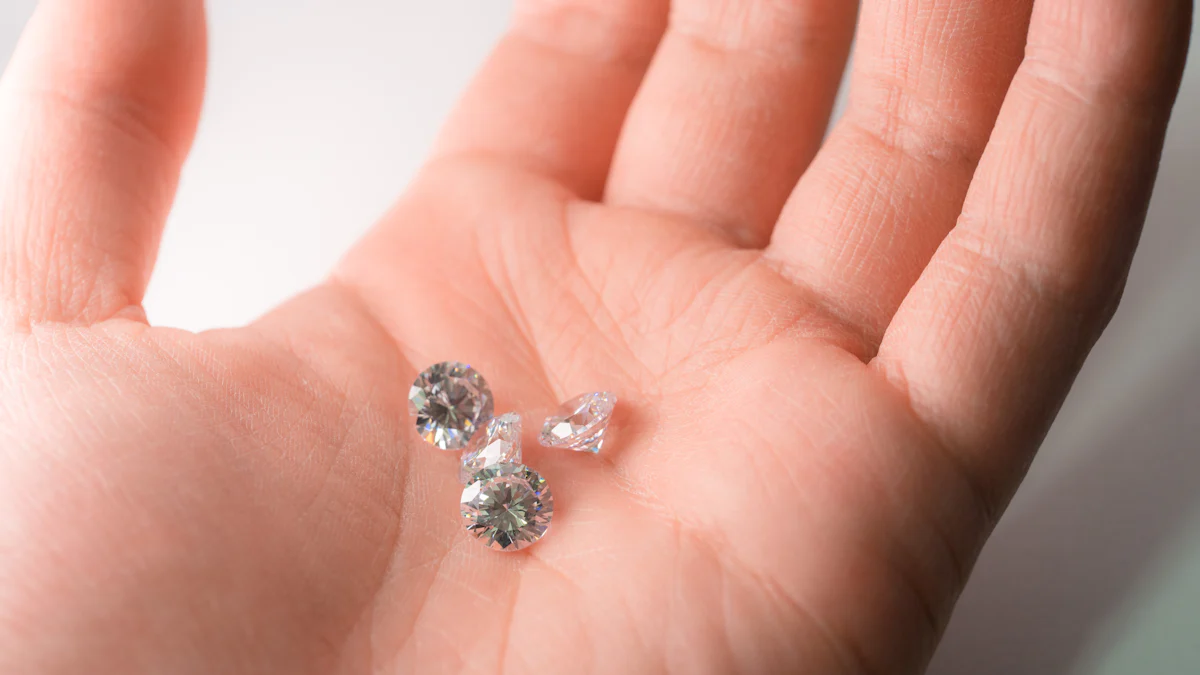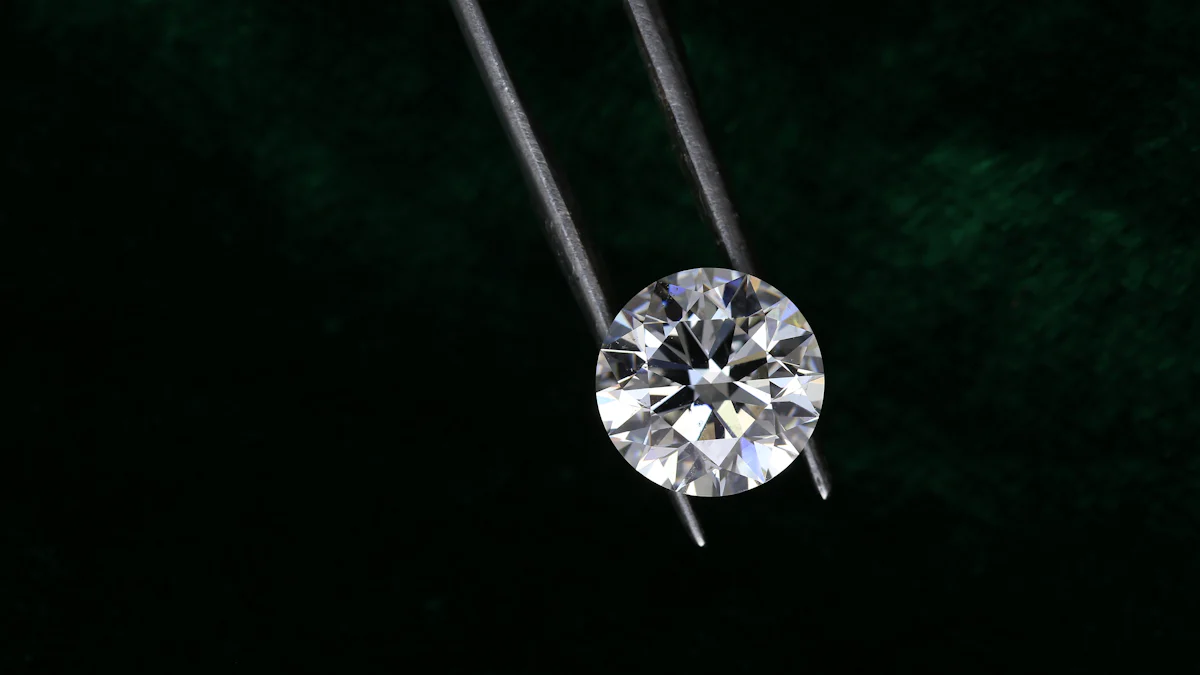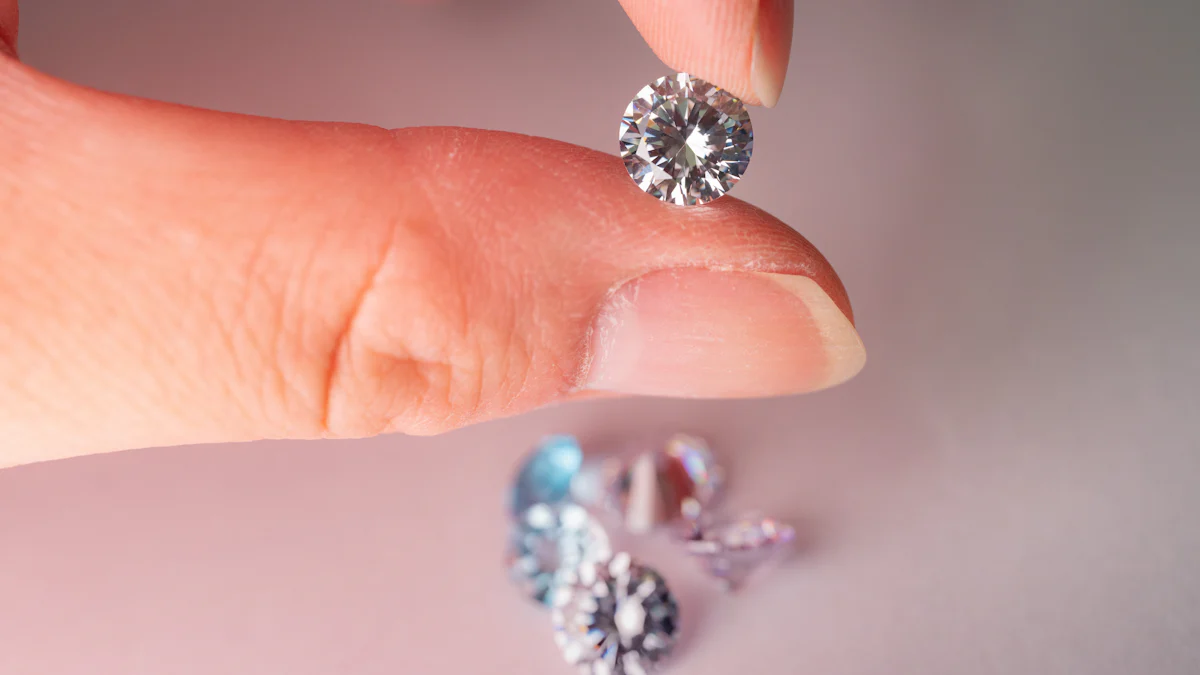Guide to Investing in VS1 vs VVS1 Diamonds

When you consider investing in diamonds, the choice between VS1 vs VVS1 can significantly impact your decision. VVS1 diamonds often stand out as a better investment due to their rarity and higher resale value. However, if you seek a stunning diamond without breaking the bank, a VS1 diamond offers excellent beauty and value. Clarity plays a crucial role in determining a diamond's worth. Fewer inclusions mean a cleaner appearance, enhancing both brilliance and durability. Understanding these clarity grades helps you make informed investment choices.
Understanding VS1 vs VVS1 Clarity Grades

When you invest in diamonds, understanding clarity grades is crucial. The clarity of a diamond affects its appearance and value. Let's explore the differences between VS1 and VVS1 clarity grades.
What is VS1 Clarity?
VS1, or "Very Slightly Included," refers to diamonds with minor inclusions that are difficult to see under 10x magnification. These inclusions do not affect the diamond's brilliance or beauty to the naked eye.
Characteristics of VS1 Diamonds
- Eye-Clean Appearance: You will find that VS1 diamonds appear flawless without magnification.
- Excellent Value: These diamonds offer a balance between clarity and cost, making them a popular choice for many buyers.
Common Inclusions in VS1
- Small Crystals: Tiny crystals may be present but are not visible without magnification.
- Feathers: Minor feather-like inclusions can occur, yet they do not compromise the diamond's durability.
What is VVS1 Clarity?
VVS1, or "Very, Very Slightly Included," represents diamonds with exceptional clarity. Inclusions in these diamonds are extremely small and challenging to detect even for experts.
Characteristics of VVS1 Diamonds
- Near-Pristine Quality: VVS1 diamonds are almost flawless, with inclusions that are nearly invisible under magnification.
- Rarity and Prestige: These diamonds are rare, representing less than 1% of all diamonds, and are highly sought after by collectors.
Common Inclusions in VVS1
- Pinpoints: Tiny pinpoint inclusions may exist but are incredibly hard to spot.
- Minuscule Clouds: Occasionally, small cloud-like inclusions can be found, yet they do not affect the diamond's visual appeal.
Understanding these clarity grades helps you make informed decisions when investing in diamonds. Whether you choose a VS1 or VVS1 diamond, both offer unique benefits that cater to different preferences and budgets.
Comparing VS1 vs VVS1 Diamonds

When you explore the world of diamonds, understanding the differences between VS1 vs VVS1 can guide your investment decisions. Both clarity grades offer unique benefits, but they differ significantly in terms of price, visual appeal, and investment potential.
Price Differences
The price of a diamond often reflects its clarity. VVS1 clarity diamonds are among the most expensive due to their superior clarity and rarity. In contrast, VS1 diamonds provide a more affordable option while still maintaining excellent clarity.
Market Trends for VS1
- Affordability: Many buyers choose VS1 diamonds for their balance of clarity and cost. These diamonds offer great value without compromising on beauty.
- Popularity: The VS1 diamond price remains attractive to those seeking quality without a hefty price tag.
Market Trends for VVS1
- Premium Pricing: VVS1 diamonds command higher prices due to their near-pristine clarity. They are often seen as a luxury purchase.
- Rarity: The rarity of VVS1 clarity diamonds contributes to their higher market value, making them a sought-after choice for collectors.
Clarity and Visual Appeal
Clarity plays a crucial role in a diamond's visual appeal. Both VS1 and VVS1 diamonds can appear eye clean, but their clarity grades impact their perceived value.
Impact on Aesthetics
- VS1 Diamonds: These diamonds offer an eye clean appearance, meaning inclusions are not visible to the naked eye. They provide excellent brilliance and beauty.
- VVS1 Diamonds: With fewer inclusions, VVS1 diamonds boast superior brilliance and a flawless look, enhancing their aesthetic appeal.
Perceived Value
- VS1 Diamonds: Buyers often perceive these diamonds as offering great value for their price, balancing clarity and cost.
- VVS1 Diamonds: The higher clarity of VVS1 diamonds increases their perceived value, making them a prestigious choice.
Investment Potential
Investing in diamonds requires understanding their potential for appreciation. Both VS1 and VVS1 diamonds have their own investment merits.
Historical Appreciation
- VS1 Diamonds: Historically, VS1 diamonds have shown steady appreciation, appealing to budget-conscious investors.
- VVS1 Diamonds: These diamonds have demonstrated significant appreciation over time, reflecting their rarity and high demand.
Future Market Predictions
- VS1 Diamonds: Experts predict that VS1 diamonds will continue to hold their value, offering a stable investment option.
- VVS1 Diamonds: The future looks promising for VVS1 diamonds, with expectations of continued demand and value growth.
Understanding the nuances of VS1 vs VVS1 diamonds helps you make informed decisions. Whether you prioritize cost, clarity, or investment potential, both options offer unique advantages tailored to different preferences and budgets.
Factors to Consider When Choosing VS1 vs VVS1
When deciding between VS1 and VVS1 diamonds, several factors can influence your choice. Understanding these elements helps you make a well-informed investment decision.
Size and Shape
The size and shape of a diamond significantly impact its value and appeal. Larger diamonds often command higher prices due to their rarity. However, the shape also plays a crucial role in determining a diamond's desirability.
Influence on Value
- Size Matters: Larger diamonds tend to be more valuable. They are rarer and often seen as more prestigious.
- Shape Appeal: Certain shapes, like round or princess cuts, are more popular and can enhance a diamond's value. These shapes often maximize brilliance and clarity, making them attractive to buyers.
Popular Shapes for Investment
- Round Brilliant: This shape is the most popular and offers excellent brilliance. It is a classic choice for investors seeking a balance of quality and cost.
- Princess Cut: Known for its modern appeal, the princess cut is a favorite among investors. It provides a unique look while maintaining high clarity.
- Emerald Cut: This shape emphasizes clarity and is often chosen for its elegant appearance. It appeals to those who appreciate understated beauty.
Certification and Authenticity
Ensuring that your diamond is certified and authentic is crucial for investment purposes. Certification provides proof of a diamond's quality and authenticity, which is essential for resale and maintaining value.
Importance of Certification
- Proof of Quality: Certification verifies a diamond's characteristics, such as clarity, cut, and carat weight. This information is vital for assessing its value.
- Resale Assurance: A certified diamond is easier to sell. Buyers trust certified diamonds more, knowing they meet specific quality standards.
Trusted Certification Bodies
- Gemological Institute of America (GIA): The GIA is renowned for its rigorous grading standards. It is a trusted authority in the diamond industry.
- American Gem Society (AGS): Known for its strict grading criteria, the AGS provides reliable certification. It is respected by investors and jewelers alike.
When investing in diamonds, consider these factors to ensure you make a sound decision. Whether you choose VS1 or VVS1, understanding size, shape, and certification will guide you toward a valuable investment.
Pros and Cons of Investing in VS1 vs VVS1
When you consider investing in diamonds, understanding the pros and cons of VS1 and VVS1 clarity grades can guide your decision. Each offers unique benefits and challenges that cater to different investment goals.
Pros of VS1 Diamonds
Cost-Effectiveness
VS1 diamonds provide an excellent balance between beauty and cost. You get a visually stunning appearance without the premium price associated with higher clarity grades like VVS1. This makes buying a VS1 diamond a practical choice if you seek quality and value without overspending. The VS1 diamond price remains attractive for those who want to invest wisely.
Availability
VS1 diamonds are more readily available compared to their VVS1 counterparts. This availability ensures you have a wider selection to choose from, allowing you to find the perfect diamond that meets your preferences and budget. The abundance of VS1 diamonds in the market also contributes to their competitive pricing.
Cons of VS1 Diamonds
Lower Clarity
While VS1 diamonds offer excellent value, they have slightly lower clarity compared to VVS1 diamonds. This means they may contain more inclusions, although these are often not visible to the naked eye. If you prioritize the highest clarity, you might find VS1 diamonds less appealing.
Resale Challenges
The resale value of VS1 diamonds can be challenging. Although they maintain good value, they may not appreciate as significantly as VVS1 diamonds. If you plan to resell your diamond in the future, consider this potential limitation.
Pros of VVS1 Diamonds
Higher Clarity
VVS1 diamonds are renowned for their exceptional clarity. They contain very few inclusions, making them nearly flawless. This high clarity enhances their brilliance and appeal, making them a prestigious choice for investors who value quality above all else.
Prestige and Demand
The rarity and near-pristine quality of VVS1 diamonds command higher prices. They are highly sought after by collectors and investors alike. This demand ensures that VVS1 diamonds retain their value over time, making them a worthwhile investment if you seek prestige and long-term appreciation.
Understanding these pros and cons helps you make informed decisions when investing in diamonds. Whether you choose VS1 or VVS1, each offers distinct advantages that align with different investment strategies and personal preferences.
Cons of VVS1 Diamonds
Higher Cost
When you consider purchasing VVS1 diamonds, you must be prepared for a higher price tag. These diamonds are renowned for their extraordinary clarity and rarity, which significantly increases their cost. The VVS1 diamond price reflects their near-pristine quality, making them one of the most expensive clarity grades available. While they offer exceptional beauty, the premium you pay may not always translate into a noticeable difference in quality when viewed with the naked eye. This means that if you prioritize budget over absolute clarity, you might find the cost of VVS1 diamonds prohibitive.
Limited Availability
VVS1 diamonds are not only costly but also scarce. Their rarity contributes to their prestige and investment potential, yet it also means you have fewer options to choose from. This limited availability can make it challenging to find the perfect diamond that meets your specific preferences and requirements. You might need to compromise on other factors, such as size or shape, to secure a VVS1 diamond. If you value having a wide selection, the scarcity of VVS1 diamonds could pose a significant drawback.
Understanding these cons helps you weigh the benefits and drawbacks of investing in VVS1 diamonds. While they offer unmatched clarity and prestige, their higher cost and limited availability might not align with every investor's goals.
In your journey of investing in diamonds, understanding the nuances between VS1 and VVS1 clarity grades proves essential. VS1 diamonds offer a cost-effective choice, maintaining high clarity standards while being more budget-friendly. They appear flawless to the naked eye, making them an attractive option for those seeking value without compromising on beauty. On the other hand, VVS1 diamonds stand out for their extraordinary clarity and rarity, commanding higher prices and appealing to collectors who prioritize perfection. Your choice should align with your investment goals—whether you seek affordability or prestige.
FAQ
What makes diamonds a good investment?
Diamonds can be a valuable addition to your investment portfolio. They offer long-term growth potential, durability, and intrinsic value. Unlike other assets, diamonds maintain their worth over time due to their rarity and demand.
How do VS1 and VVS1 diamonds differ in terms of investment?
VS1 and VVS1 diamonds differ mainly in clarity. VVS1 diamonds have fewer inclusions, making them rarer and often more valuable. This rarity can lead to higher resale value. VS1 diamonds, while slightly less clear, offer excellent value for their price.
Are VVS1 diamonds worth the higher cost?
VVS1 diamonds command higher prices due to their exceptional clarity and rarity. If you prioritize clarity and prestige, VVS1 diamonds can be worth the investment. However, if budget is a concern, VS1 diamonds provide a more cost-effective option without sacrificing beauty.
Can I expect my diamond investment to appreciate over time?
Historically, diamonds have shown steady appreciation. Both VS1 and VVS1 diamonds have potential for value growth. However, market trends and demand can influence appreciation rates. It's essential to consider these factors when investing.
What should I look for in a diamond certification?
Certification ensures your diamond's quality and authenticity. Look for certifications from trusted bodies like the Gemological Institute of America (GIA) or the American Gem Society (AGS). These organizations provide reliable assessments of a diamond's characteristics.
How does diamond size and shape affect investment value?
Diamond size and shape significantly impact value. Larger diamonds are rarer and often more valuable. Popular shapes like round or princess cuts can enhance a diamond's appeal and investment potential due to their brilliance and demand.
Is it challenging to resell VS1 diamonds?
Reselling VS1 diamonds can present challenges. While they maintain good value, they may not appreciate as significantly as VVS1 diamonds. If resale is a priority, consider this factor when choosing between VS1 and VVS1.
Why are VVS1 diamonds less available?
VVS1 diamonds are rare due to their high clarity and limited inclusions. This rarity contributes to their prestige and investment potential but also means fewer options are available. You might need to compromise on other factors to secure a VVS1 diamond.
How do I choose between VS1 and VVS1 diamonds?
Your choice depends on your investment goals. If you seek affordability and value, VS1 diamonds are ideal. For those prioritizing clarity and prestige, VVS1 diamonds offer unmatched quality. Consider your budget and long-term objectives when deciding.
Can diamonds be part of a diversified investment portfolio?
Yes, diamonds can diversify your investment portfolio. They offer stability and potential growth, complementing other assets. As Lauren Foster noted, diamonds' durability and intrinsic value make them a wise addition to any investment strategy.
See Also
A Comprehensive Approach to Selecting a White Diamond Ring
Exploring Different Diamond Cuts for Engagement Jewelry
Your Ultimate Resource for Choosing a Diamond Ruby Ring

